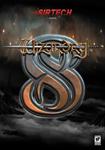Each core category and the auxiliary category Combat also have related
Should Have conditions; the reviewer should make a comment if a sub list item is not fulfilled. Should one or more (SH) not be fulfilled the game is most likely a special CRPG (see Tags) or a CRPG light.
If all (SH) are fulfilled too there's no further discussion necessary — the game is a true CRPG.
1. Character Development
Describes ways to create, change or enhance your characters in order to increase their effectiveness in the game.
- SC1: You can create your characters. Yes
- SC2: Pre-planning is required for character development Yes
- SC3: Tactical use of abilities is required (➙ primary means of problem solving, gameworld interaction and overcoming challenges. The player's physical coordination skills are secondary.) Yes
2. Exploration
Includes how you can move through the game world, as well as everything you can find, see, manipulate or interact with, like locations, items and other objects.
- SE1: You can find NPCs (➙ non-player characters who you can interact with.) Yes
- SE2: You can choose a path (➙ there is at least some branching.) Yes
- SE3: You can interact with the game world (➙ e.g. you can pull levers, push buttons, open chests, hack computers, … appropriate to the game's setting) Yes
- SE4: The gameworld can affect your characters' conditions or circumstances such that you have to learn and adapt to overcome these challenges (➙ e.g. weather, traps, closed doors, poisoned areas, …) Yes
- SE5: Inaccessible areas can be reached due to character enhancements or by solving quests or puzzles (➙ e.g. unlock locked areas, overcome obstacles, repair bridges, dispel barriers, …) Yes
3. Story
Concerns all narrative elements like setting, lore, plot, characters, dialogue, quests, descriptions, storyline(s) and similar, including how you can interact with them.
- SS1: You can interact with information sources (➙ e.g. NPC conversations, riddle statue questions, …) Yes
- SS2: You can make choices in those interactions. Yes
- SS3: Some of those choices have consequences. Yes
- SS4: Thinking is required in order to progress (➙ e.g. irreversible choices, moral dilemma, riddles, …) Yes — limited
- SS5: The story is influenced by your decisions and your characters' actions and stats or abilities. Yes
4. Combat (Meta)
Describes how combat (or more general: conflict resolving) corresponds to elements of Character Development, Exploration and Story.
- SF1: Combat is influenced by character stats or abilities (➙ e.g. amount of damage, chance to hit, weapon access, …) Yes
- SF2: Combat involves random elements (➙ e.g. game internal dice rolls.) Yes
- SF3: Combat provides some challenge (➙ e.g. requires preparation, use of tactics or environment.) Yes


